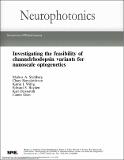| dc.contributor.author | Stahlberg, Markus A | |
| dc.contributor.author | Ramakrishnan, Charu | |
| dc.contributor.author | Willig, Katrin I | |
| dc.contributor.author | Boyden, Edward S | |
| dc.contributor.author | Deisseroth, Karl | |
| dc.contributor.author | Dean, Camin | |
| dc.date.accessioned | 2021-10-27T20:10:43Z | |
| dc.date.available | 2021-10-27T20:10:43Z | |
| dc.date.issued | 2019 | |
| dc.identifier.uri | https://hdl.handle.net/1721.1/135095 | |
| dc.description.abstract | © 2019 The Authors. Optogenetics has revolutionized the study of circuit function in the brain, by allowing activation of specific ensembles of neurons by light. However, this technique has not yet been exploited extensively at the subcellular level. Here, we test the feasibility of a focal stimulation approach using stimulated emission depletion/reversible saturable optical fluorescence transitions-like illumination, whereby switchable light-gated channels are focally activated by a laser beam of one wavelength and deactivated by an overlapping donut-shaped beam of a different wavelength, confining activation to a center focal region. This method requires that activated channelrhodopsins are inactivated by overlapping illumination of a distinct wavelength and that photocurrents are large enough to be detected at the nanoscale. In tests of current optogenetic tools, we found that ChR2 C128A/H134R/T159C and CoChR C108S and C108S/D136Aactivated with 405-nm light and inactivated by coillumination with 594-nm lightand C1V1 E122T/C167Sactivated by 561-nm light and inactivated by 405-nm lightwere most promising in terms of highest photocurrents and efficient inactivation with coillumination. Although further engineering of step-function channelrhodopsin variants with higher photoconductances will be required to employ this approach at the nanoscale, our findings provide a framework to guide future development of this technique. | |
| dc.language.iso | en | |
| dc.publisher | SPIE-Intl Soc Optical Eng | |
| dc.relation.isversionof | 10.1117/1.NPH.6.1.015007 | |
| dc.rights | Article is made available in accordance with the publisher's policy and may be subject to US copyright law. Please refer to the publisher's site for terms of use. | |
| dc.source | SPIE | |
| dc.title | Investigating the feasibility of channelrhodopsin variants for nanoscale optogenetics | |
| dc.type | Article | |
| dc.contributor.department | Massachusetts Institute of Technology. Media Laboratory | |
| dc.contributor.department | McGovern Institute for Brain Research at MIT | |
| dc.contributor.department | Massachusetts Institute of Technology. Department of Brain and Cognitive Sciences | |
| dc.contributor.department | Massachusetts Institute of Technology. Department of Biological Engineering | |
| dc.relation.journal | Neurophotonics | |
| dc.eprint.version | Final published version | |
| dc.type.uri | http://purl.org/eprint/type/JournalArticle | |
| eprint.status | http://purl.org/eprint/status/PeerReviewed | |
| dc.date.updated | 2019-07-19T16:21:52Z | |
| dspace.orderedauthors | Stahlberg, MA; Ramakrishnan, C; Willig, KI; Boyden, ES; Deisseroth, K; Dean, C | |
| dspace.date.submission | 2019-07-19T16:21:56Z | |
| mit.journal.volume | 6 | |
| mit.journal.issue | 01 | |
| mit.metadata.status | Authority Work and Publication Information Needed | |
